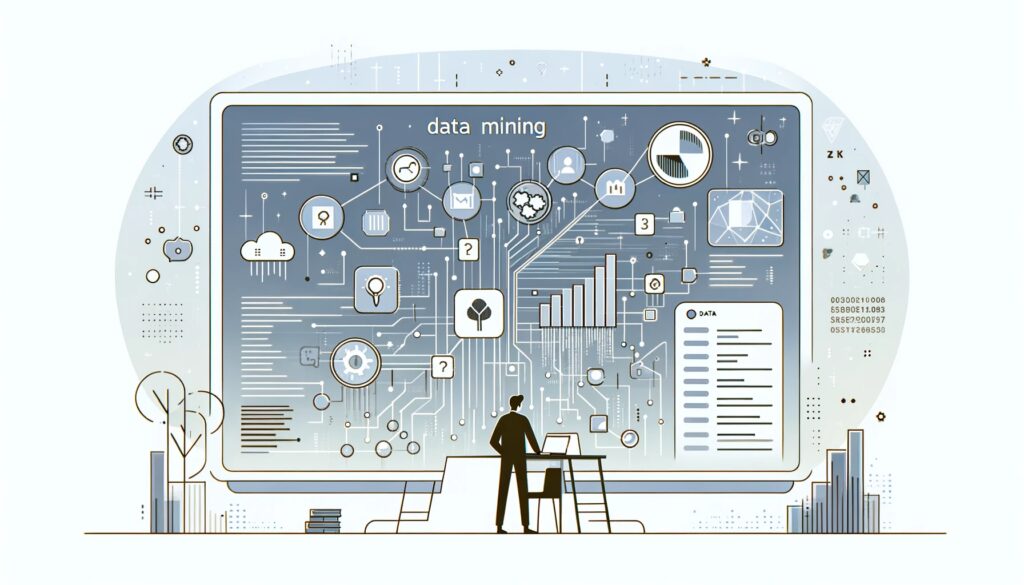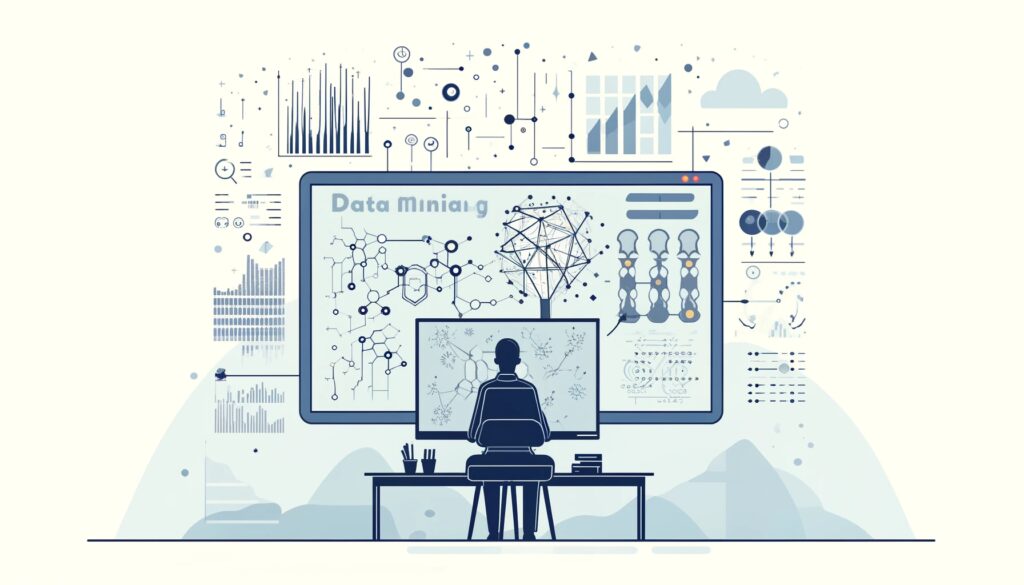
Unlocking Hidden Patterns with Data Mining
Data mining is a powerful process that unearths patterns and knowledge from vast data sets. It’s an intersection of artificial intelligence, machine learning, statistics, and database systems. Over the years, it has evolved from basic data analysis techniques to sophisticated algorithms capable of handling big data applications. In today’s business world, data mining enhances decision-making, optimizes operations, and drives strategic initiatives through valuable data insights.
Essential Data Mining Techniques
Regression Analysis
Regression analysis is a straightforward yet potent technique used to predict a value based on other variables. Imagine using historical sales data to predict future revenue – that’s regression in action.
Association Rule Discovery
This technique is all about identifying relationships between variables in large databases. For instance, retailers use it to understand which products are frequently bought together, enhancing cross-selling opportunities.
Classification
Classification involves categorizing data into predefined classes. It’s like sorting emails into spam and non-spam folders automatically.
Clustering
Clustering groups similar data points together. Think of it as segmenting your customer base into distinct groups for targeted marketing campaigns.
The Data Mining Process
- Data Collection
- Gathering data from various sources is the first step. This could be anything from customer transactions to social media interactions.
- Data Cleaning
- Ensuring data quality by removing inconsistencies and inaccuracies is crucial. Clean data is the foundation of reliable analysis.
- Data Transformation
- This involves normalizing and aggregating data to prepare it for analysis. It’s like tuning your car’s engine for optimal performance.
- Data Modeling
- Applying algorithms to extract patterns and insights is where the magic happens. This step transforms raw data into actionable intelligence.
- Evaluation and Interpretation
- Finally, assessing the results for accuracy and relevance ensures that the insights are both reliable and useful.
Powerful Tools and Software
Apache Hadoop
Apache Hadoop is a heavyweight in the data mining world, enabling distributed processing of vast data sets across clusters of computers. Its scalability and fault tolerance make it ideal for handling big data.
KNIME
KNIME, an open-source data integration and analysis platform, offers a user-friendly interface and a broad range of extensions. It allows for seamless workflow creation, from data preprocessing to complex predictive modeling.
Rattle
Rattle is a graphical user interface for data mining using R. It simplifies the process of data exploration and model building, making advanced analytics accessible to users without deep programming knowledge.
RapidMiner
RapidMiner is a comprehensive data science platform that provides tools for data preparation, machine learning, deep learning, text mining, and predictive analytics. Its drag-and-drop interface and extensive libraries cater to both novice and expert users.
Diverse Applications
Healthcare
In healthcare, data mining is transforming patient care by predicting outcomes and personalizing treatment plans. By analyzing patient records and clinical data, hospitals can enhance diagnostic accuracy and treatment effectiveness.
Finance
In the finance sector, data mining is crucial for fraud detection and credit scoring. By sifting through transaction data and identifying unusual patterns, financial institutions can prevent fraudulent activities and assess credit risks more accurately.
Retail
Retailers leverage data mining for market basket analysis and customer segmentation. Understanding purchase patterns and customer preferences allows for personalized marketing and improved inventory management.
Manufacturing
Manufacturers use data mining for predictive maintenance and quality control. By analyzing production data, they can predict equipment failures and ensure consistent product quality, thus reducing downtime and operational costs.

Emerging Trends in Data Mining for 2024
AI Integration
Artificial intelligence is revolutionizing data mining by enhancing predictive capabilities and automating complex tasks. AI-driven analytics offer deeper insights and more accurate predictions, transforming how businesses operate.
Real-Time Data Mining
The demand for real-time insights is growing, driving the adoption of technologies that process data as it is generated. This enables businesses to respond swiftly to market changes and operational issues, maintaining a competitive edge.
Ethical Data Mining
With increasing concerns about data privacy, ethical data mining practices are becoming essential. Companies must navigate the delicate balance of extracting value from data while ensuring compliance with privacy regulations and maintaining customer trust.
Edge Computing
Edge computing brings data processing closer to the data source, reducing latency and bandwidth usage. This trend is particularly beneficial for applications requiring real-time analysis, such as IoT devices and autonomous systems.
Essential Data Mining Techniques
Regression Analysis
Regression analysis is a straightforward yet potent technique used to predict a value based on other variables. Imagine using historical sales data to predict future revenue – that’s regression in action.
Association Rule Discovery
This technique is all about identifying relationships between variables in large databases. For instance, retailers use it to understand which products are frequently bought together, enhancing cross-selling opportunities.
Classification
Classification involves categorizing data into predefined classes. It’s like sorting emails into spam and non-spam folders automatically.
Clustering
Clustering groups similar data points together. Think of it as segmenting your customer base into distinct groups for targeted marketing campaigns.
“Mitigating biases in data and algorithms is crucial for ethical data mining. Companies must ensure their models are trained on representative datasets and regularly audited for bias to promote fairness.”
— EMB Global
Addressing Challenges in Data Mining
Data Quality
Ensuring the accuracy, completeness, and consistency of data is a perennial challenge. High-quality data is crucial for reliable insights, and businesses must implement robust data validation and cleansing processes.
Scalability
Handling the exponential growth of data volumes is another significant challenge. Modern data mining tools are designed to scale efficiently, but managing this growth requires continuous innovation and adaptation.
Skill Gap
There is a notable shortage of professionals with expertise in data mining and analytics. Investing in training and education is essential to bridge this gap and equip the workforce with the necessary skills.
Integration
Combining data from disparate sources and systems can be complex. Effective integration strategies and tools are required to unify data, ensuring comprehensive and cohesive analysis.

Insightful Case Studies and Industry Examples
E-commerce
In the e-commerce sector, data mining is used to personalize product recommendations, significantly boosting sales. By analyzing browsing patterns and purchase history, companies can offer tailored suggestions to their customers.
Energy
Data mining helps optimize energy consumption and reduce costs in the energy sector. By analyzing usage patterns and external factors, companies can develop more efficient energy management strategies.
Social Media
On social media platforms, data mining analyzes user behavior and sentiment to create targeted marketing campaigns. Understanding user interactions and preferences allows businesses to engage their audience more effectively.
Future Directions and Research Areas
Quantum Data Mining
Quantum computing holds promise for revolutionizing data mining with its potential to solve complex problems faster than classical computers. Research in this area is exploring how quantum algorithms can enhance data analysis.
Automated Machine Learning (AutoML)
AutoML simplifies the model-building process by automating many of the steps involved in creating machine learning models. This trend is making advanced analytics more accessible to non-experts.
Deep Learning
Leveraging neural networks for complex pattern recognition, deep learning is pushing the boundaries of what data mining can achieve. It enables more sophisticated analyses and predictions, particularly in unstructured data.
Interdisciplinary Approaches
Combining data mining with fields like genomics and environmental science opens up new possibilities for research and application. These interdisciplinary approaches are driving innovation and expanding the impact of data mining.
Ethical and Legal Considerations
Data Privacy
Ensuring compliance with regulations like GDPR is paramount in data mining. Businesses must implement robust data protection measures and obtain explicit consent for data collection and processing to avoid legal pitfalls.
Bias and Fairness
Mitigating biases in data and algorithms is crucial for ethical data mining. Companies must ensure their models are trained on representative datasets and regularly audited for bias to promote fairness.
Transparency
Making data mining processes and outcomes understandable to stakeholders is essential for building trust. Transparent practices involve clearly documenting methodologies, algorithms, and decision-making processes.
Educational and Training Resources
Online Courses
Platforms like Coursera and edX offer a plethora of data mining courses. These courses cater to various skill levels, from beginners to advanced practitioners, providing flexibility in learning.
Workshops and Conferences
Events like ICDM and WSDM provide excellent opportunities for networking and learning. These conferences feature workshops, keynotes, and sessions on the latest research and industry practices in data mining.
Academic Programs
University degrees specializing in data science and analytics are becoming increasingly popular. These programs provide comprehensive education in data mining techniques, tools, and applications, preparing students for careers in this dynamic field.
Real-Time Market Monitoring
Benefits
Real-time market monitoring enables businesses to respond immediately to market changes and competitor actions. This agility is crucial in maintaining a competitive edge and capitalizing on emerging opportunities.
Techniques
Using data mining tools to monitor social media, stock prices, and news articles in real-time provides valuable insights. These tools can track trends, sentiments, and anomalies, helping businesses make informed decisions quickly.
Competitive Analysis
Strategies
Leveraging data mining to gain insights into competitors’ strategies is a game-changer. Businesses can analyze competitor activities, pricing strategies, and customer feedback to refine their own tactics and stay ahead in the market.
Tools
Automated scraping and analysis of public data sources are essential for competitive intelligence. These tools gather and process vast amounts of data from competitor websites, social media, and news articles, offering a comprehensive view of the competitive landscape.
Customer Insights for Marketing
Behavior Analysis
Understanding customer preferences and purchase history through data mining allows businesses to create highly personalized marketing campaigns. By analyzing past behaviors, companies can predict future needs and tailor their offerings accordingly.
Predictive Models
Anticipating customer needs using predictive models enhances marketing efforts. These models use historical data to forecast trends and behaviors, enabling businesses to deliver personalized recommendations and promotions at the right time.
Trend Forecasting
Methods
Analyzing historical data and social media trends is key to predicting future market shifts. Businesses use statistical models and machine learning algorithms to identify emerging patterns and forecast trends accurately.
Applications
Aligning product development and marketing strategies with anticipated trends helps companies stay ahead of the curve. By understanding potential market changes, businesses can adapt their offerings and promotional activities to meet future demands effectively.
Data Mining in Education
Student Performance Analysis
Data mining is revolutionizing education by identifying at-risk students and tailoring interventions. By analyzing academic performance and behavioral data, educators can develop personalized support plans to enhance student success.
Learning Analytics
Improving teaching methods and educational outcomes through data is becoming increasingly common. Learning analytics enables educators to refine instructional strategies, ensuring that students receive the most effective and engaging education possible.
Data Mining in Public Health
Disease Outbreak Prediction
Using**d data to predict and manage health crises is a vital application of data mining. By monitoring trends in public health data, authorities can anticipate outbreaks and implement preventative measures in a timely manner.
Personalized Medicine
Developing tailored treatment plans based on patient data is another groundbreaking application of data mining in public health. By analyzing genetic, clinical, and lifestyle data, healthcare providers can offer treatments that are customized to individual patients, improving outcomes and reducing side effects.
Resources for Further Learning
Websites and Blogs
Websites like Built In and Data Science Central are excellent resources for staying updated on the latest trends and tutorials in data mining. They offer a wealth of information, from beginner guides to advanced techniques.
Books and Journals
Key publications in the field of data mining and machine learning provide in-depth knowledge and research findings. These resources are essential for anyone looking to deepen their understanding of data mining.
Professional Associations
Associations such as IEEE and ACM offer networking and professional development opportunities. These organizations host conferences, publish journals, and provide resources that are invaluable for data mining professionals.
Conclusion
Data mining is a transformative technology that continues to evolve, offering new techniques and tools to uncover hidden insights in vast data sets. By understanding and leveraging these methods, businesses can enhance decision-making, optimize operations, and drive strategic initiatives. As we move forward into 2024, staying abreast of the latest trends and best practices in data mining will be crucial for any organization looking to harness the power of data.